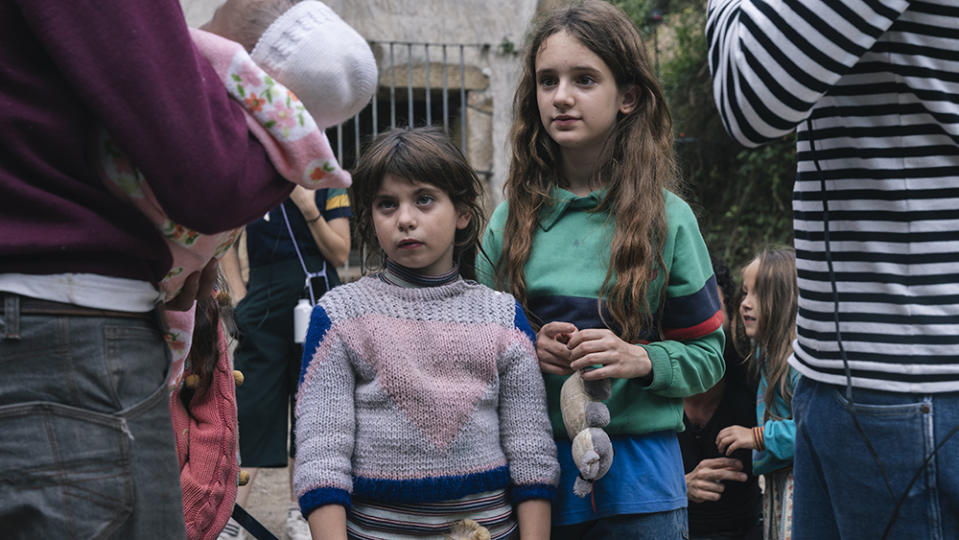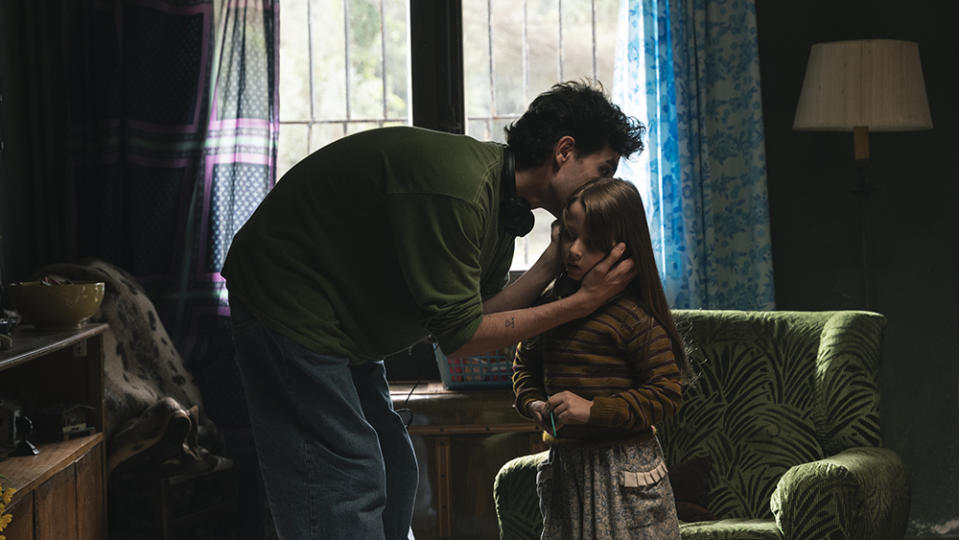On Set With ‘Veneno’ Creators Los Javis Shooting Their Follow-Up, ‘La Mesías,’ and First-Look Images (EXCLUSIVE)
- Oops!Something went wrong.Please try again later.
- Oops!Something went wrong.Please try again later.
- Oops!Something went wrong.Please try again later.

In “La Mesías,” their follow-up as writers-directors to ‘Veneno,’ an HBO Max pickup for the U.S., Spanish showrunners Javier Calvo and Javier Ambrossi are promising their biggest series yet, a “near apocalyptic family drama,” as Ambrossi puts it, which chronicles the deep scars left for decades by childhood trauma.
In it, Enric, in the modern-day, is heavily impacted watching a viral video of a five-sister Christian pop band. Enric himself is still battling childhood memories marked by religious fanaticism and a mother with delirious messianic ambitions.
More from Variety
MipCancun 2022: Booming Attendance, Biopics, Movies, Co-Pros, and an End to the Era of Volume
Erik Barmack, Jimena Rodríguez Set 'Pequeñas Indiscreciones,' 'El Susurro del Angel' (EXCLUSIVE)
Sofía Auza's 'Adolfo,' from The Immigrant, Unveiled by Fremantle at MipCancun (EXCLUSIVE)
A Movistar+ Original, which is sold by Movistar+Internacional,“La Mesías” is produced by Ambrossi and Calvo at Suma Content, the robustly independent and internationally-minded production house launched last year by Los Javis, as they are popularly known in Spain,
Part of that brewing apocalypse was on show in late October in scenes shot at a masia, a traditionally farmsteads reconverted into a family home, in a placid mini-sierra of abrupt forested hills an hour’s drive south of Barcelona.
Variety caught up with them on set and savoured the singular shooting style of two partners who must surely rate as one of the hottest acts in Spain’s entertainment business.
The Scene
Hell has no fury like a Spanish matriarch. Lola Dueñas, co-star of “Veneno” as its go-getting TV reporter, plays Montserrat, the family’s mother and termagant tantrum queen. In the scene caught on set, she breaks the news of the father’s imminent departure to her young daughters, aged between 5 and 12. Many mothers would do that gently. Not so Montserrat who throws a tizzy fit, laced with religious references, taking the departure out on her children. Her ne’er-do-well husband is a “martyr.” “You’ve got to do your tasks,” Dueñas bawls. “I don’t have the strength.” The young daughters cringe; one, the eldest, tries to comfort a younger sister; Montserrat retreats to her bedroom in self-pitying disgust.
The Heart of the Matter: Childhood
“Your mother or your father, there’s always someone who marks you forever, so you’re always in a time loop: We repeat what we learn when young, search for it in different ways,” said Calvo, talking over lunch. “It’s very difficult to unlearn what you’ve been taught – I’m talking about education – the past resounds in your body for ever. That touches me in many ways. As a son, and a member of the LGBT collective. The series talks about religion, but as a form of education and this is what makes it interesting,” he added.

A Step-Up in Scale
“La Mesías” is not just the mother nor Eric’s story. It’s far more wide ranging. Playing out from the 1980s to the modern day, the seven-episode series will also follow the lives of the elder brother and young daughters. “We will follow lives from childhood to adolescence and maturity and sometimes to death. It’s a very ambitious journey in time and epochs,” said Ambrossi. It involves no studio work whatsoever. 10 weeks into an 11 week first part of the shoot, cast and crew have shot at 30-40 locations. If “Veneno” was this big, said Ambrossi, extending his hands,”’La Mesías’ is double,” he added, doubling the space between them. Movistar+, part of Telefonica – one of Europe’s biggest telecoms reporting €29.8 billion ($29.8 billion) in first nine-month revenues – is a natural partner.
Filming as Fun
So how do the Javis behave on set? They spent a lot of time playing with the child actors. They also laugh a lot. The scene that they are shooting is loaded with pain: The mother’s descent into neurosis, opening the door to religious fanaticism; the young daughters’ inevitable trauma. But when Ambrossi sits before a monitor to check out the shots, he chortles with glee at
a very young daughter’s on point performance. On-set lunch has something of the festive air of a holiday camp. The Javis have a particular way of directing and living shoots, and they’re connected, said Dueñas (“The Sea Inside”). “They want everybody to be well and happy, they give a lot of love, are totally committed. They bring out the best in you.”
Genre Blending
There are other readings to Ambrossi’s laughter, however. The Javis, he notes, always try to do something different. 2017’s “Holy Camp,” their first feature, was a musical. “Paquita Salas,” their first series airing from 2016, a show biz comedy, 2020’s “Veneno” a biopic. “La Mesías” is a “suspense-driven emotional mystery-thriller made by auteurs, each episode leaving questions and a desire to watch more,” said Ambrossi. But “we never lose who we are,” added Calvo. One hallmark is the light found in any family dramas. There’s always something which makes you smile.” Another is genre cocktails. “We don’t like things to be just one thing. If you make a thriller, it doesn’t mean you can’t laugh or be moved. We like this mix and in this mix there’s always one element that’s ours and ours alone,” Calvo adds.

”Costumbrismo”
Costumbrismo – a detailed depiction of local, often rural local life – flowered in Spain’s nineteenth century. But it has remained to this day. Part of the delight of “Veneno,” apart from what’s been praised as its authentically accurate portrait of trans women and transition, is the slanguage of many characters and faithfully depicted, often messy habitats. “Holy Camp” renders lovingly a summer camp, light filtering through trees at early dawn. Ambrossi and Calvo inspected seven masias before choosing the one they shot in for “La mesías.” Its rooms are littered with the remnants of bourgeois respectability and a rural past – a big armchair and sofa; a bookcase with pot-boiler books which haven’t been opened in decades; tiled walls; an art nouveau glass design over the main entrance,; white concrete Moorish arches forming a second floor facade – and the litter of childhood: An old Barbie doll, a worn rocking horse, multiple battered teddy bears: the caringly rendered decor of a family on the slide.
High Style
Detailed, sometimes gritty in their realism, Los Javis also, however, employ high style. “La Mesías” is no exception. Told much in flashback, shuttling from one period to the next and filtered through the (maybe sometimes unreliable) memories of its main characters, past periods are shot in the aesthetics of the time – 16 mm and warmer colours. The modern day adapts cooler, aseptic aesthetics, said Ambrossi. Each character will have their universe, portrayed in a different style; episodes vary in genre, tone and length: “Some will be an hour or more, others shorter, with comedy scenes, thriller, drama, even musical moments,” he added. “When you mix past and present, the series becomes more than a family story. It’s about characters trying to fit together the pieces of their lives, determining who they really are to see if they can recover from the past.”
So The Javi Paradox
The realism, yet high style of Los Javis is one fruitful tension. Another is narrative control. “We know exactly what we want for editing,” said Ambrossi. They have to, given the enormous narrative jigsaw they have planned. Not for nothing, development of the series, including research of the issues involved, took more than 18 months. But the Javis then shot with two cameras, Calvo giving instructions to the children on how to react in the scene seen on set. More than improvisation, “I’d call it the moment of truth,” said Calvo. “The ideas you bring from home are enemies of what happens in a scene and is true and surprises you and could only be shot at that moment. I like to know what I want but also see how actors, all of us, interpret it.”
Best of Variety
Sign up for Variety’s Newsletter. For the latest news, follow us on Facebook, Twitter, and Instagram.

